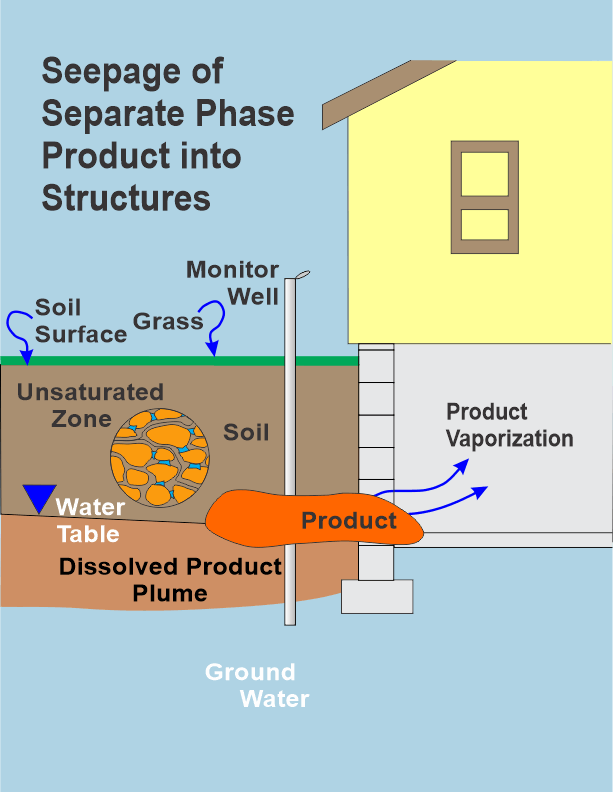
| |
 |
earthDr! "the
environmental ombudsman"
earthDRx.org - prescriptions (Rx) for |
|
SEEPAGE
OF PRODUCT INTO A BASEMENT: causing
vapors in a home
|
Where have we come in our understanding of possible subsurface exposure routes to our homes or work environments?
Contaminants commonly enter our living space from the subsurface either through basements, crawl spaces, slabs, or via potable drinking water supplied by individual residential wells. Typically, contaminant concentrations of concern do not enter our living space from public supply wells due to stricter monitoring requirements. We have seen that contaminant entry through a basement wall is possible. The earlier figure depicted seepage of gasoline contaminated groundwater into a basement. Vapors were generated when gasoline volatilized from the gasoline-contaminated groundwater that seeped into the basement. This is just one mechanism for the entry of gasoline into a basement.
 |
Another common method for the entry of gasoline into a basement is depicted by the figure on this page. In this figure, gasoline product (not gasoline dissolved in water) seeps through a basement wall and not groundwater contaminated by dissolved gasoline components. The seeps of gasoline then vaporize contaminating the air we breathe with gasoline components. First, a little explanation is in order. Equal volumes of gasoline and water don't weigh the same. Equal volumes of gasoline and water have different masses. A given volume of water has a greater mass than does gasoline. Therefore, gasoline is bouyant on water and can float on it. Again, take note of the elliptical area to left of the text depicted as "Soil" in this figure. This area depicts a blowup of a section of soil. Soil particles are depicted in orange with voids in between them. There will always be voids (known as pore spaces) between the soil particles, no matter how tightly (densely) the soil particles are packed. Voids in soils, such as these, are known as pore spaces. When these soil pore spaces are below the water table they typically are completely filled with water. Soil pore spaces above the water table are filled with various amounts of both water and air.
At
the water table the soil pores are completely filled with water.
If sufficient gasoline is lost to the subsurface, gasoline will be found
floating above the interface, known as the water table, since gasoline
is bouyant on water. A product, such as gasoline, is depicted above
the water table. The soil pores are now filled with another liquid,
other than water. The bouyant liquid, present in the soil pores,
can float above the water table. The soil pores above this floating
product are filled with varied amounts of water, product, and air.
Other products, such as TCE (trichloroethylene), having a greater mass
per volume (density) than water can sink below the water table and seep
into your basement. It later will be illustrated that even gasoline which
floats on the surface of a water body, often times, can sink below the
water table and seep into your basement contaminating it with vapors of
benzene, toluene, ethylbenzene, xylene isomers, MTBE, and TBA.
TREATISE
- VAPOR GENESIS IN STRUCTURES (CONTINUED)
TREATISE - REMEDIATION OF VAPORS RESULTING FROM PRODUCT SEEPS